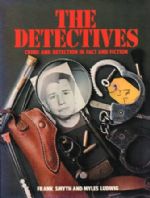THE DETECTIVES Crime and Detction in Fact and Fiction
Author: Smyth (Frank) & Ludwig (Myles)
Year: 1978
Publisher: New Burlington Books
Edition Details: 1st Edn.
Book Condition: NrF/NrF
ISBN: 0906286018
Price: £7.00
IN STOCK NOW
Hardback. The detective enforces society's rules, yet he cannot always play by them. He has human emotional responses to his work, yet he may have to contain them. He is sometimes an insider, sometimes an outsider, often a cynic. His work may at times be dangerous, yet he must be unafraid. It is his job to strip away the cloak of mystery in which the criminal wraps himself. Forever trapped between the law and the law-breaker, the gut reaction and the facts, the truth and the alibi, the detective has universally become an intriguing figure, a compelling character in fiction, a hero and sometimes an anti-hero. Fictionalised, he may be a loner like Philip Marlowe, a scientific detective like Sherlock Holmes, or a plodder like Lestrade. He may be a gentleman, like Poirot, or a racy, tough-guy in the style of Starsky and Hutch. But how true in life are these fictional images? The authors provide some clues, comparing popular detectives of books, magazines, film, radio and television with great real-life detectives whose most famous cases are presented here in fascinating detail. In fiction, the detective often acts on a hunch. In real life, he rarely does. Chief Inspector John Wilson Murray was an exception. He put his career on the line when he made a spectacular arrest in Niagara Falls. Not all assignments are intended to prove guilt. Sometimes a detective is hired to establish the innocence of his client. Raymond Campbell Schindler was a master defender who will long be remembered for his investigation of the Sir Harry Oakes murder in the Bahamas. A lover of good food who bore a close resemblance to the fat TV detective, Frank Cannon, he was much admired by Erle Stanley Gardner, creator of Perry Mason. G.K. Chesterton's detective/priest, Father Brown, was known for his ability to think himself into the mind of a murderer. Detective Inspector Arthur Fowler Neil used the same technique, "becoming" his quarry, in order to catch the Brides-in-the-Bath slayer. The former Pinkerton detective-turned-mystery-writer who invented Sam Spade - the clairvoyant who solved a mass murder - the 'bent cop' who was also a great pioneering detective - the female murder victim who left a most off-beat clue in the history of criminology - these and many other stars of real-life dramas people the pages of this book. Profusely Illus. in colour and b/w. + Index. 191pp. 4to. h/back. From the library of true crime writer, Wilfred Gregg, with his personal b/plate. V. lightly browned edges o/w Nr. F. in Nr. F. dw. A fairly heavy book which will require additional postage.
Titles Recently Added To The Catalogue
Wants list
If you're after a particular title, enter your details below
Selling a Book?
Enter the details below and we'll be in touch shortly


